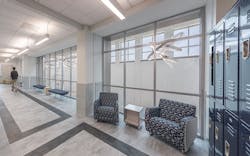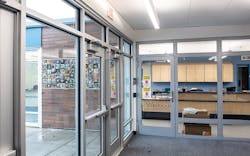Passing The Test for Safer School Design
With the threat of school-targeted violence, how can the building industry work together to ensure the safety of students and teachers? One way is to examine current building code requirements to understand how potential increases in school safety and security standards could help school building design anticipate and better protect students and faculty from life safety threats.
There are best-practice guidelines for designing safer schools, which are a great starting point. That said, without national, standardized codes in place, determining whether or not an element of a building’s design fulfills established best practices remains uncertain. This often translates to added responsibility on the designer’s end to ensure an architectural element contributes to a project’s security goals. This may include examining local and national building codes and policies, consulting with code officials, building product manufacturers and more.
Currently, neither the Life Safety Code from the National Fire Protection Association (NFPA) or the International Building Code (IBC) requires forced-entry or ballistic-rated materials (though local jurisdictions may adopt more stringent requirements than these model codes). Schools that intend to improve the security of their buildings through glass do so voluntarily. The elective nature of designing safer schools leaves a lot of uncertainty as to whether or not an assembly fulfills security recommendations while also meeting other fire and life safety code requirements.
In addition, it’s critical to take into account the principles of occupant-centered design—including how architectural systems can contribute to a positive experience during day-to-day operation. Because glass assemblies can meet testing requirements for fire, forced-entry and bullet-resistance ratings while also contributing to open, light-filled designs, they can meet several of the considerations for designing more welcoming and safer schools.
To ensure these multifunctional systems deliver on all fronts, it is important to address compatibility. However, this is easier said than done. When marrying products together to create multifunctional offerings, some security-rated products may negatively impact the performance of fire-rated components. Whether voluntary security standards become codified or not, the incorporation of forced-entry- or ballistic-rated products should not compromise the level of protection a building can provide during a fire. Therefore, it’s important to know both the testing standards and the logic of their protocols. Doing so helps ensure an entire system will provide the level of protection intended for a project, no matter the threat to life safety.
Understanding different testing standards for fire-, force-entry- and ballistic-rated glazing
Rated glass must meet testing standards from third-party agencies, such as Intertek or Underwriters Laboratories (UL). The scope of these tests varies depending on what safety and security functions a glazing component needs to fulfill. Based on the results of these tests, products will be given a qualified rating that indicates the level of protection they offer.
For fire-rated glass, these qualifications include the type of protection provided and the duration. Fire-rated glass can be “fire-protective” or “fire-resistive,” depending on the material’s ability to block fire, smoke and radiant heat as determined by the UL 263 or ASTM E119 testing standards. Fire-resistive assemblies block all three while fire-protective assemblies only block fire and smoke. Fire ratings are further qualified by how long an assembly can withstand a controlled fire—often ranging from 20 to 180 minutes. It is important to note that in the US fire-rated glazing that exceeds a 20-minute rating must also pass the hose stream test.
Comparatively, forced-entry ratings convey how long a glazing assembly can withstand attacks from intruders and are measured in accordance with the ASTM E2395 and ASTM F3561 testing standards. Assemblies that meet forced-entry resistance ratings grant occupants more time to enact lock-down protocols and contact emergency response teams. As such, they can be a key component in meeting multiple tiers described in the Partner Alliance for Safer Schools (PASS) safety and security guidelines for K-12 schools. It should be noted that forced-entry rating standards are not concerned with fire ratings or bullet-resistance. Instead, this standard measures how long an assembly can block entry.
Bullet resistance for glazing assemblies is most commonly measured by the UL 752 testing standard, which provides eight levels of protection. The levels correspond not only with the number of shots an assembly can withstand but also ammunition type. Each increasing level indicates a higher capacity for absorbing the energy from a projectile.
All these testing standards are conducted in controlled environments to provide a repeatable testing protocol. While this helps create a unified understanding of how a material may be able to protect occupants, it does not account for the nearly infinite ways threats to life safety can occur—or predict circumstances that may compromise a rating.
Designing safer schools by identifying blind spots in testing protocols
Testing agencies develop their protocols to address the general parameters of threats to life safety. For example, a door undergoing the fire test would be subjected to a predetermined baseline temperature that is increased at a set rate to more closely simulate a fire in real life. Forced-entry and bullet-resistance rating tests also have predetermined protocols to both create a universal rating standard and to closely model real-life events.
However, it should be noted that systems are not required to be tested to multiple standards. For assemblies that incorporate multiple forms of protection, each component only needs to pass the test that determines its rating—fire-rated components only need to pass fire tests, and forced-entry rated components only need to pass forced-entry tests. There is no overlap between testing protocols. For glazing assemblies, this may complicate the process of specifying a multifunctional, fire-rated system.
For instance, forced-entry or ballistic-rated products, like films, are often plastic-based, which means they can readily catch fire and burn quite intensely. As such, in the event of a fire, these materials may exceed both the temperature-rise and maximum temperature parameters used during the fire test, effectively reducing the level of protection these assemblies provide. While protecting students and faculty from violent intruders and active shooters is a real concern, it should not override the need to provide adequate safety during a fire—especially given the NFPA estimates there to be over 3,000 fires on school campuses annually.
To accomplish safer school designs, especially in areas where multiple threats to life safety overlap—such as exit corridors, entry vestibules, stairwells and more—building designers can turn to multifunctional, fire-rated systems that are either jointly tested as a complete system or are made with compatible parts. These types of assemblies mitigate unintentional consequences of combining rated components.
Ensuring one form of protection is not compromised for another is paramount as the building industry works to improve life safety and security. Not examining component compatibility could lead to costly reworks or worse: inadvertently specifying a system that delivers less protection than desired. How can these outcomes be avoided? Is it by expanding code requirements? Is it by listing product compatibility?
About the Author

Devin Bowman, TGP
Devin Bowman is General Manager of Technical Glass Products (TGP) and AD Systems. With over 20 years of industry experience, Bowman is actively involved in advancing fire- and life-safety codes and sits on the Glazing Industry Code Committee (GICC).
Email: [email protected]
Contact him at: (800) 426-0279


